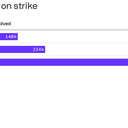Forget the summer of strikes ... 2023 was a year of strikes

Forget the "summer of strikes," 2023 was a full year of walkouts: The number of workers who walked off the job surged by 141% last year from 2022, per a report out Thursday morning.
Why it matters: The strong labor market of the past few years fueled a rise in support for unions and worker organizing, emboldening organizers to take a harder line — pushing folks to the picket lines.
- The results were great for these workers — especially in the four biggest walkouts of the year, where they scored big double-digit raises, bonuses, better benefits, and other assorted goodies.
Driving the news: The action continues this year. On Tuesday, drivers for Uber and delivery workers from DoorDash refrained from working.
Zoom in: While the overall number of strikes only ticked up a bit in 2023, many more workers were involved in stoppages.
- This was mainly due to four big strikes across a range of industries — health care (Kaiser Permanente workers), manufacturing (United Auto Workers), media (actors and writers), and education (L.A. school workers).
- These four actions alone involved a total of 350,100 workers, out of a total of 539,000 out on strike in 2023, according to the tally from Cornell's School of Labor & Employment Relations.
The top three demands among striking workers are better pay; improved health and safety; and increasing staffing (those latter two were both a big concern for Kaiser Permanente employees who said understaffing negatively affected patient care).
Another notable trend: Workers went on strike simply to push for a first contract. That's the first order of business for any new union — hammering out salary and benefit terms.
- The contract is a big deal. "Workers do not see a benefit, unless they get a contract," notes Alex Colvin, dean of Cornell's ILR school. U.S. labor law doesn't have a mechanism to compel companies to negotiate with unionized employees.
- So far a first contract has proved elusive for workers from Starbucks, Trader Joe's and Amazon who recently voted to unionize.
- The 74 work stoppages over first-contract demands in 2023 were more than double the previous year.
Uber and Lyft drivers, meanwhile, aren't in a union. Gig workers and fast food employees have had more success outside of traditional union channels, notes Colvin. Gaining higher minimum wages in a few places, for example.
- One of the most effective tactics of unions over the last decade has been efforts like "Fight for $15" that leverage labor power at the policy level, he says.
In the weeds: Cornell has only tracked this data since 2021 so it's hard to make historical comparisons. That said, the 2023 numbers are in line with the 21st-century highs of 2018 and 2019 that were reported by the Bureau of Labor Statistics — and nowhere near the highs seen in the 1970s.
- (The government doesn't track strikes with fewer than 1,000 workers — but because last year was so dominated by big labor actions, we can draw some comparisons.)
What to watch: All eyes are on the UAW's efforts in the South — a notoriously hard place to organize. "If they win, that would be a really big victory for organized labor," Colvin says.